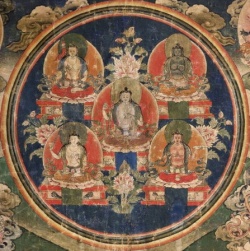ISYT Conference: First Day
ISYT Conference Day 1
 Mr. Gurung’s discussion of some finer points of Bön po history opened the conference, after a great welcome from conference convener Elijah Ary and superb speeches by the eloquent and genuinely funny Charles Ramble (President of IATS) and Brandon Dotson (President of ISYT). Dr. Ramble certainly stole the show on this first day with his well timed scholastic jokes and clear speaking voice. Notable moments of the commencement speeches include: Elijah noting the importance of the local for this second ISYT conference. The city of light has never held a IATS or ISYT conference and the venues (Ecole Normale Superieure, Bibliotheque Sainte-Barbe, INALCO and musee du quai Branly) are legendary. Charles compared his receipt of an invitation to give the opening speech to a description of the stages of shock a patient goes through when learning they have contracted an incurable disease, and Brandon noted the importance of a venue where a collegial attitude was the focus and young scholars could feel safe to “stick our neck out” with new ideas without fear of rebuke. The feeling was collegial, but perhaps a little subdued by humility as the honor of standing in the Ecole Normale Superieure began to sink in.
Mr. Gurung’s discussion of some finer points of Bön po history opened the conference, after a great welcome from conference convener Elijah Ary and superb speeches by the eloquent and genuinely funny Charles Ramble (President of IATS) and Brandon Dotson (President of ISYT). Dr. Ramble certainly stole the show on this first day with his well timed scholastic jokes and clear speaking voice. Notable moments of the commencement speeches include: Elijah noting the importance of the local for this second ISYT conference. The city of light has never held a IATS or ISYT conference and the venues (Ecole Normale Superieure, Bibliotheque Sainte-Barbe, INALCO and musee du quai Branly) are legendary. Charles compared his receipt of an invitation to give the opening speech to a description of the stages of shock a patient goes through when learning they have contracted an incurable disease, and Brandon noted the importance of a venue where a collegial attitude was the focus and young scholars could feel safe to “stick our neck out” with new ideas without fear of rebuke. The feeling was collegial, but perhaps a little subdued by humility as the honor of standing in the Ecole Normale Superieure began to sink in.
The first day’s presentations:
Kalsang N. Gurung (Leiden University, Holland)
Mr. Gurung’s presentation was renamed at the last moment to “Where do they come from? Expansion of ancestors and other members of gshen rab mi bo’s family.” His presentation was divided into four short discussions of 1) gshen rab’s father’s name, 2) gshen rab’s mother’s name, 3) his eight brothers and one sister, and 4) his key disciples. My jet-lag kicked in and the first two sections are a bit of a blur, but suffice to say that Gurung referred to Dunhang texts PT1134 and PT1235 and discussed the possible origin of the various versions of names given in a hagiography of gshen rab mi bo, which he argued were cobbled together by the author from texts from the mid-11th century and perhaps earlier. The names originated in a large corpus of early documents and their lack of clarity is what is most notable. The most interesting point, it seemed to me, came in the discussion of the third part. While in some accounts gshen rab is an only child, in Gurung’s study, a list of eight brothers and one sister is given. gshen rab appears to be the youngest son in this list. Further, the eight brother’s names accord with the first eight of the “9 vehicles” of Bon teachings. gshen rab then accords with the final stage, rdzogs chen, the ninth vehicle. The direct connection is not mentioned in the text, as the reference to the siblings comes early on in the text and the description of the “9 vehicles” comes in the 17th chapter of the hagiography. Gurung noted that the first five brother’s names match the first five vehicle names exactly, with the others becoming clear references when the descriptions of the brothers are given. Without any other reference for this presentation, Gurung was left with many questions and his fourth point caused more questions from the audience, as the creation of a common Tibetan theme of a trinity of teacher and two heart sons (thugs sras) was identified. It appears that, much like the Buddha (Shariputra and Maudgalyayana) gshen rab also had two heart sons. Gurung’s discussion was cut short, but his thesis should prove to be of great interest to those studying the Bön tradition as pieces of the hagiography of gshen rab mi bo appear to be unique and he makes reference to many Dunhuang texts.
More to come soon… and pictures!

